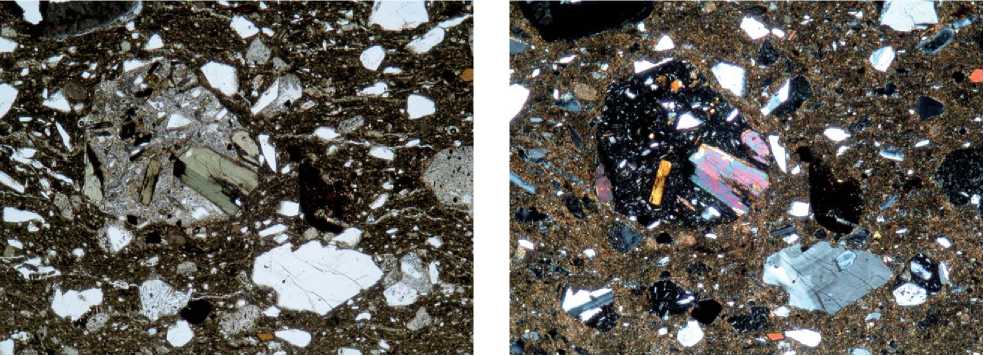Petrology A field of geology which focuses on the study of rocks and the conditions by which they form. There are three branches of petrology, corresponding to the three types of rocks: igneous, metamorphic, and sedimentary.
Polarizer A device that converts an unpolarized or mixed-polarization beam of electromagnetic waves (e. g., light) into a beam with a single polarization state (usually, a single linear polarization).
Thin section A laboratory preparation of a rock, mineral, or soil sample for use with a polarizing petrographic microscope.
In the 1930s it was realized that materials constituting the fabric of a pot are a source of valuable archaeological information. Before the advent of scientific analysis, archaeologists assumed that most coarse wares were locally produced, but subsequent petrological research has shown that in several cases they were traded, sometimes over very long distances. This applies particularly to some prehistoric wares and to later utilitarian pottery, such as kitchenware, thick-walled storage ware, and specialized products such as cooking ware and transport containers. Coar-seware fabrics contain 10-30% inclusions and voids, and can be likened to sedimentary rocks. On this principle, analytical techniques have been adapted from petrological methods developed in the Earth sciences. These include examining the composition, frequency, size, morphology, and arrangement of inclusions, voids, and the fired clay matrix that make up the ceramic fabric. Ceramic petrography is the process of describing these properties at macroscopic (visible to the unaided eye) and microscopic levels of magnification. Ceramic petrology, on the other hand, is the broader study of ceramic classification, production, and trade based on the results of petrographic analysis.
There are several advantages in using ceramic petrology. Macroscopic analysis can be undertaken in the field with minimal equipment, allowing rapid and efficient examination of large pottery assemblages of up to tens of thousands of sherds. Observations from these studies can be directly related to results from laboratory-based microscopic analyses. The latter generate much more accurate data, but consider only a limited number of samples, typically 20-300. As petrography maintains the structural integrity of the fabric, technological information can be acquired concerning the potters’ selection and processing of raw materials, forming techniques and firing conditions. Perhaps most importantly, analysis of mineral and rock inclusions in the pottery allows direct com-parision with regional geology and its related literature. Of course, there are disadvantages too. Ceramic petrology relies heavily on the analyst’s interdisciplinary experience. The diverse ways in which potters interact with geological materials mean that there are few reliable rules to guide fabric classification and interpretation. Quantification of petrographic results does help, but it is a complex and time-consuming process. Ceramic petrologists therefore take great care in defining appropriate archaeological questions, selecting samples, testing various classificatory schemes, and exploring interpretive models before delivering a conclusion.
Instrumentation used in petrography is relatively affordable and widely available. It operates at three levels: hand lens, stereomicroscope, and polarizing microscope. Hand lenses (x10) are used in field assessments when classifying large quantities of pottery using macroscopic characteristics. Stereomicroscopes (x20-x100) provide improved resolution in

Figure 1 Thin section of a pottery fabric containing volcanic rock and mineral inclusions viewed in plane-polarized light. Similar to natural light, a polarizing filter under the sample means that light striking the thin section is vibrating in only one plane (top to bottom). As a result, the green amphibole characteristically changes color on rotation. Most inclusions are colorless plagio-clase feldspar and quartz, distinguished from voids (thin wavy lines) by their gray to white interference colors under crossed polars (Figure 2). Note that the large rock fragment with green amphibole is rounded, indicating that the grain has been transported. Width of field is 4.2 mm.
Figure 2 Same sample as Figure 1 Viewed under crossed polars. A second polarizing filter has been inserted above the thin section, at 90° to the lower polarizer, that is, left to right. All undisturbed light is blocked, so voids and volcanic glass appear black. Most of the sample refracts light so it can still be seen as false interference colors caused by the disturbed light path, for example, interference colors of the green amphibole are blue to red. Interferences colors go into extinction (black) four times on rotation as each inclusion is aligned with the upper and lower polarizing filters. Width of field is 4.2 mm.
Both field and laboratory environments. These techniques are used to study fresh breaks in pottery and require minimal sample preparation and damage to artifacts, but the accuracy of inclusion identification is severely limited. Polarizing microscopes (x20-x600) are the most powerful tool, but require samples of 10 x 20 mm2 or more to be removed from the pot and prepared as thin sections in the laboratory. To make a thin section, a flat surface is ground on the sample, which is then mounted on a glass microscope slide before being ground down to a final thickness of 0.03 mm. Ideally, enough sample is removed for at least two thin sections in case one is lost in grinding. When ground to a thickness of
0.03 mm, rock and mineral inclusions become translucent and can be identified under the polarizing microscope using the light refracted through them. Polarizing filters control the two types of lighting conditions commonly used: plane-polarized light (Figure 1) and crossed polars (Figure 2). Minerals are identified by their structure and by optical properties measured with reference to polarizing filter orientations.
Ceramic petrology operates at the interface of archaeology, geology, and ceramic technology. Anna Shepard played a major role in founding this field, and her book, Ceramics for the Archaeologist, continues to be indispensable, despite being largely updated by Rice. Nevertheless, some of the challenges that Shepard faced resulted from archaeologists’ difficulty in fully appreciating the application and value of her studies. Pottery analyses (see Pottery Analysis: Chemical; Stylistic) have come a long way since then, but few archaeologists have first-hand experience of working with ceramic petrology. The questions posed need be archaeologically sound, but also appropriate to both the technique and the pottery available for study. Sampled pottery must be accurately classified by shape and decoration for fabric distinctions to be mapped into archaeologically meaningful categories. It is likewise advantageous if different rock types occur in discrete parts of the study region. A useful guide is to view the analysis in four stages, each developing new insights: description, characterization, technology, and provenance. Description identifies the geological nature and diversity of a pottery assemblage or ware, whereas characterization is used to sort similar fabrics into geological and/or technological groups using a structured set of criteria. Technology and provenance are more demanding levels of interpretation concerned with pottery production and trade/exchange networks.




 World History
World History









